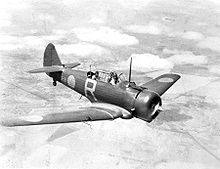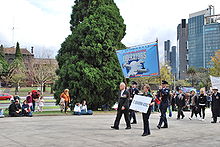- No. 21 Squadron RAAF
-
21 Squadron 
A No. 21 Squadron Wirraway in 1940Active 1936 – present Branch RAAF Role Air Base operations & Reserve training Part of No. 396 Combat Support Wing RAAF Garrison/HQ RAAF Williams; Laverton Base Motto "Coronat Victoria Fortes" (Victory Crowns the Brave) Commanders Notable
commandersCharles Eaton (1937–38) No. 21 Squadron is a Royal Australian Air Force general reserve squadron. It saw action as a fighter, dive bomber and heavy bomber unit during World War II.
Contents
History
No. 21 Squadron was formed at RAAF Base Laverton in April 1936, as a Citizen Air Force (reserve) squadron. Shortly after the outbreak of World War II, it began operating CAC Wirraways.[1]
Fighter unit in Malaya
In mid-1941, as war with Japan became more likely, the squadron was re-designated a fighter unit and was sent to augment four other British Commonwealth units in Malaya, including No. 453 Squadron RAAF. The only fighter available was the Brewster Buffalo.[1]
The five British Commonwealth units — including two RAF and one RNZAF squadrons — that flew Buffalos in the Malayan campaign were beset with numerous problems, including: poorly-built and ill-equipped planes;[2][3] inadequate supplies of spare parts;[3] inadequate numbers of support staff;[2][3] airfields that were difficult to defend against air attack;[2] lack of a clear and coherent command structure;[2] antagonism between RAF and RAAF squadrons and personnel,[2][3] and inexperienced pilots lacking appropriate training.[2]
 Brewster Buffalo aircraft of No. 21 Squadron flying over a Malayan airfield.
Brewster Buffalo aircraft of No. 21 Squadron flying over a Malayan airfield.
No. 21 Squadron suffered severe losses to Japanese fighters, on the ground and in the air, during the first week of the campaign, resulting in its operational merger with 453 Squadron, and later with other Buffalo squadrons. Surviving pilots were evacuated to the Dutch East Indies and from there to Australia. The squadron was disbanded in Fremantle in March 1942.[1]
Bomber squadron in Australia
In September 1943 No. 21 Squadron was re-formed at Gawler, South Australia and re-equipped with Vultee Vengeance dive bombers[4]. In December the unit moved to Lowood in Queensland for advanced training. In January and February 1944 the squadron then moved to Nazdab in New Guinea. By the end of February the unit had commenced attacks on Japanese barge hide-outs on the Wagol River[4], and was part of combined raids with other squadrons on the airstrips at Hansea Bay, Madang and Alexishafen.
Following further attacks in March against enemy camps around Pommern Bay and Rempi village, it was decided the short flying range of the Vengeance was unsuitable for the New Guinea campaign and No. 21 Squadron returned to Australia on 13 March 1943. Moving to Camden, the squadron converted to B-24 Liberator heavy bombers in June 1943. The unit did not see operational service again until January 1945, when it attacked targets at Laga and a radio station at Moena Island[4]. During January and February more than a hundred missions were flown against Japanese targets. In April the squadron attacked a convoy of ships near Koepang, damaging a cruiser. Other targets attacked included troop areas at Tawo and fuel tanks in Tarakan and Borneo. The squadron's operations in the last months of the war were concentrated around supporting the allied landings at Labuan and Balikpapan[1]. Following the end of the war the unit's aircraft were used as shipping escorts and as transports before returning to Tocumwal, New South Wales.
Post-war
In December 1947, No. 21 Squadron, now located at RAAF Base Amberley began to replace its Liberators with Avro Lincoln bombers. An aircraft was lost at Amberley on 19 February 1948, killing all 16 people on board.[5] After being briefly renamed No. 2 Squadron from February to April 1948, the squadron was re-formed as No. 21 (City of Melbourne) Squadron at RAAF Williams as a Citizen Air Force (reserve) fighter squadron. It flew CAC Wirraway, P-51 Mustang and de Havilland Vampire aircraft from 1948 until 1960.[5] The squadron ceased flying operations in 1960 and became a non-flying general reserve squadron headquartered at RAAF Williams near Melbourne. On 1 July 2010, No. 21 (City of Melbourne) Squadron amalgamated with Combat Support Unit Williams to become an integrated Permanent Air Force and Reserve unit responsible for airfield and base support and reserve training.[6]
Footnotes
- ^ a b c 21 Squadron RAAF, Australian War Memorial, http://www.awm.gov.au/units/unit_11055.asp
- ^ a b c d e f Squadron Leader W.J. Harper, 1946, "REPORT ON NO. 21 AND NO. 453 RAAF SQUADRONS" (UK Air Ministry), p.1 (Source: UK Public Records Office, ref. AIR 20/5578; transcribed by Dan Ford for Warbird's Forum.) Access date: 8 September 2007
- ^ a b c d Harper, p.2
- ^ a b c Norman Barnes (2000). The RAAF and the Flying Squadrons. Allen & Unwin, New South Wales ISBN 1-86508-130-2. Page 92.
- ^ a b Norman Barnes (2000). The RAAF and the Flying Squadrons. Allen & Unwin, New South Wales ISBN 1-86508-130-2. Page 93.
- ^ Andrew Stackpool, 2010, "Over to you now" (Australian Government Dept of Defence), p.6) Access date: 9 January 2010
References
- RAAF Museum 21 Squadron
- Australian War Memorial 21 Squadron RAAF
Main series 1 · 2 · 3 · 4 · 5 · 6 · 7 · 8 · 9 · 10 · 11 · 12 · 13 · 14 · 15 · 20 · 21 · 22 · 23 · 24 · 25 · 26 · 27 · 28 · 29 · 30 · 31 · 32 · 33 · 34 · 35 · 36 · 37 · 38 · 40 · 41 · 42 · 43 · 60 · 66 · 67 · 71 · 73 · 75 · 76 · 77 · 78 · 79 · 80 · 82 · 83 · 84 · 85 · 86 · 87 · 92 · 93 · 94 · 99 · 100 · 102 · 107 · 292 · Fighter · Rescue and Communication · Seaplane · Berlin Air Lift
Article XV squadrons Joint Netherlands-Australian squadrons Categories:- RAAF squadrons
- Military units and formations established in 1936
Wikimedia Foundation. 2010.


